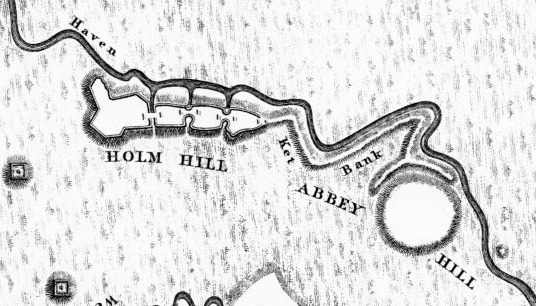Passed off as glacial erratics, bluestones were neither glacial, nor erratic. And they were only blue on special occasions. Thu 19 May 2022

Bluestones... neither glacial, erratic. Or blue. Source: Apocalypto (2014)
Bluestones and references to bluestones are an enigmatic aspect of countries bordering the North Sea.
:
From The Blue Stone of Widecombe:
The origin of the term bluestone has not been ascertained, but the colour blue seems irrelevant to the instances known to me. There is no strong formal reason why the first element should not be Scandinavian: blōð - ‘blood’ or even blōt - ‘sacrifice”
Further supporting this blood-related explanation is the case of the Blåstein (Bluestone), near the 9th C Gokstad ship-burial at Sandar in Norway. This stone was originally called the blotstein, or ‘sacrifice stone’
Green then tells of many other blue stones, from Northern England and Scotland, but also from Scandinavia, the Netherlands, Flanders (northern Belgium), and parts of Germany, with the examples in Flanders additionally being often associated with prehistoric burial mounds. Similarly to the Lincolnshire stones, these national and international examples also had a function as boundary-stones, court-stones or even execution-stones.
From Moot Hills: quoting Francis Grose's Antiquities of Scotland, 1797, Introduction, p iv:
In ancient times, courts for the administration of justice were generally held in the open fields, and judgement was both given and executed in the same place; in every earldom, and almost every barony and jurisdiction of any considerable extent, there was a particular place alloted for that purpose; it was generally a small eminence, either natural or artificial, near the principal Mansion-house and was called the mote hill, or in Latin, mons placiti.
...folklore, tradition and the association of separate 'gallow' places names with moot hills on balance suggests that the usual place of execution was a separate 'gallows hill'.
Grimsby's famous 'Havelock Stone' is one of several apparent 'execution' stones in Grimsby and in nearby Lincolnshire towns. From Francis Frith:
The Havelock Stone sits outside the Welholme gallery in Grimsby,
That's roughly the location of the tiny mound on the far right in Rev W. Smith's 1825 plan of Grimsby's mounds:

Holme Hill and Ket Bank, Grimsby, UK. Source: The Monumental Antiquities of Grimsby, Rev George Oliver.
And from The Pagan Origin of Fairs, Thomas Frances George Dexter, 1932, describing the bluestone at North Thoresby, Lincolnshire:
the stone is not blue, but there is a Celtic word plu, meaning “parish,” and the “blue stone” may be a plu stone or parish boundary stone.
"Parish" is likely an earlier pronunciation of "perish". In which case, "plu stone" becomes "perish stone", or "execution stone".
From Itinerarum Curiosum, 1776 edition, William Stukeley, p24:
Between these two parishes, in a green lane northwards, stands a little stone called Elho stone, whence the name of this hundred is derived : it is about the middle thereof, and was formerly the main road across the country, now called Old Spalding Gate. Old men tell us, here was kept in ancient times an annual court; I suppose a convention, sub dio, of the adjacent parts, to treat of their general affairs.
No investigation of 'Elho' in south Lincolnshire is complete without mentioning Elloe.
Returning to Grimsby, Oliver continues:
these high places of judgment existed in every petty state throughout the island. The judge, seated upon the barrow, which is situated on the very apex of the mount, was distinctly visible, as well as the parties in the cause to be determined, to the multitudes assembled in the surrounding vallies.
Then he says:
a bank was thrown up, which connected this station (Holm Hill) with the religious hill (Abbey Hill) adjoining, and with the Roman Fosse-way; and is still distinguished by its primitive name of Ket Bank, which was bestowed upon it by the early Britons; and clearly points out the civil and religious uses to which it was appropriated in peaceable times
Georgian readers would have understood what civil and religious uses Oliver meant. But our understanding has been educated away.
From Moot Hills:
Many moot, "mote" or "mute" hills are known by that name today. Others have local names such as Court Hill, Justice Hill, Judgement Hill... Other names are 'Cuthills', 'Couthill' and 'Cuthil'.
These sounds 'Cut', 'Cout', 'Court', and also 'Ket' are often found around locations with an earlier jurisdictive or alleged sacrificial function.
In Reptile Tumuli: A Lecture, 1871, p13, John S Phené describes how events on these mounds looked:
...this worship of Satan, whose very title and description was that of the serpent, indicated strongly that it was a development of the old form of serpent worship. The officiating persons were disguised by hideous masks, as was recorded to have been the custom in the mystic ceremonies of Britain and Egypt,
Mel Gibson helps us understand:
Face-masks may be PPE. Source: Apocalypto (2014)
Perhaps face-masks offered protection against aerosolised body fluids.
Of course, historians would claim no-one should use imagery from Apocalypto to represent what happened in north west Europe, let alone Egypt.
After all, Apocalypto is ridiculed for mis-representing what happened in Central and South America:
Source: History Buffs: Apocalypto
You can see his point.
But not for Apocalypto's depiction of north-west Europe:
Assumptions make an ass out of you. Source: Prehistoric Europe was absolutely metal
Given the abundant evidence of cannibalism just south of Lincolnshire - in the south fens (West Norfolk and Cambridgeshire) - you should consider the possibility those as the remains of what their last owner thought was four rump steaks on a skewer.
In his Reptile Tumuli lecture, Phené claimed the construction and purpose of mounds was similar around the world:
the pottery and sepulchral evidences found in the American mounds were almost identical with those found in Celtic burials.
Capt. Thomas pourtrayed a rude quadruped similar in outline to some of the American mounds ; the Cow and Calf at Ilkley, (Yorkshire, UK) the White Horse in Berkshire, (UK), an effigy on the cliffs of Dorsetshire, (UK), the Dragon Hill in Berkshire, (UK), the Horned Cairns of Caithness, (Scotland) were some of such indications. Great ingenuity had, he observed, been displayed in adding to or carving away from natural deposits to produce the designs needed, of which he quoted many examples; and this custom, it appeared, was also adopted by the constructors of the tumuli in Ohio and Wisconsin, and is the most characteristic feature of the great Sphinx

Ohio serpent mound is associated with cannibal giants. Source
Oliver adds that Grimsby mound complex was used for watching mandatory competitive sports, not unlike the Olympics, but with added hunting, fishing and wildfowling. He says an embanked cursor is evidence of that and they are often found on old maps next to 'racetracks'.
Perhaps mounds started as places for competitions and for judging the results of hybrid breeding experiments.
Mounds and embanked cursors are often found near mazes. In English Turf Labyrinths, Jeff Saward describes 'The Old Maze' at Wing, Rutland:
There was formerly a bank surrounding the maze, from which it is claimed spectators watched the sport of running the labyrinth, and nearby stands a large flat-topped mound. This is a post-medieval windmill mound, first mentioned in 1634, and it is not difficult to see a connection between the siting and origin of these earthworks.
The connection between mazes and mills is not clear to me, unless Jeff Saward means bone grinding in the Narborough Mill-style and Sandon Mount, Therfield. But the connection between mazes as memory and orientation tests, and 'chop hills' as places for recycling failures is reasonably clear.
After all, not all experiments with producing hybrid slaves produce fleet-footed messenger slaves:

Ellie Phant and Rosy Cross hated sports day. Source
And not all experiments with producing hybrid slaves produce suitable house servants:

"Lord Bertie de la Vere likes his peppers tossed." Source
After sentient hybrids were introduced, testing would have needed to select for memory and initiative - combined with the required level of compliance.
Test and selection processes used to assess these traits may have morphed into today's two primary cargo cults:
- The two largest branches of government:
- legislative (parliaments, etc)
- judiciary (courts).
- Churches (religious training and assessment centres) 1

Maze in St Helena and St Mary's church, Bourn, Cambridgeshre. Source
Our word 'church' may have come from the same root as the word 'judge'. Along with its associations with 'Divine Judgement' and 'The Last Judgement'.
Our word 'Chapel' may have come from 'Chop Hill', a variant of Cuthil, like Axholme and Haxholme.
You can catch a possible transition from 'judge' to 'church' - and from 'chop hill' to 'chapel' - at ToPhonetics. Type in:
judge church
and
chop hill chapel
Set the voice to 'english_wmids' (though 'english_north' also works quite well). Then hit 'Play'...
Perfect? No. Possible? Yes.
Sport may also be a cargo cult:
Especially net-and-ball sports like lacrosse. Source: Apocalypto (2014)
© All rights reserved. The original author retains ownership and rights.
-
Copies of existing and former mazes have been found in some churches. Perhaps contestants were given time to memorise them before taking part in selection competitions. ↩
More of this investigation:
IHASFEMR
More by tag:
#mounds, #geology, #human bone, #Manimal Farm